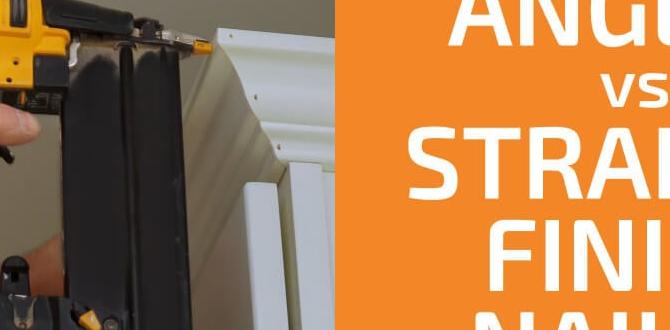To adjust air pressure for your nail gun, consult your tool’s manual for the recommended PSI (pounds per square inch) and start at the lower end of the range. Gradually increase the pressure until fasteners drive cleanly and consistently without overdriving or underdriving. Fine-tuning is key for optimal performance and tool longevity.
Hey everyone, Jack Shaffer here from Nailerguy! Ever fired up your nail gun, only to have nails pop out halfway or bore too deep into your wood? It’s a common frustration that can stop a DIY project dead in its tracks. The good news is, it’s usually a simple fix: air pressure! Getting this just right is like finding the sweet spot for your tool. It makes everything smoother, faster, and frankly, a lot more satisfying. Don’t worry, by the end of this guide, you’ll be a pro at dialing in the perfect PSI for any job. We’ll walk through it step-by-step, so you can get back to building with confidence.
Table of Contents
Why Air Pressure Matters for Your Tools
Think of air pressure as the horsepower for your pneumatic tools. It’s what gives your nail gun the oomph to drive a fastener into wood. Too little pressure, and the nail won’t go in all the way. Too much, and you risk damaging your workpiece or even your tool. Finding that perfect balance is crucial for efficiency and safety.
Different tools and different tasks require different pressures. A framing nailer might need a higher PSI to punch through tough lumber, while a brad nailer for delicate trim work will need much less. Even the type of wood you’re using can affect the ideal setting. This guide will help you understand the core principles so you can adjust with confidence.
Understanding Your Compressor and Regulator
Before we dive into adjusting, let’s get familiar with the main players: your air compressor and its regulator.
Your Air Compressor
The compressor is the heart of your pneumatic system. It’s a powerhouse that takes air from the atmosphere and compresses it into a storage tank. This compressed air is what fuels your tools. Compressors come in all shapes and sizes, from small, portable units perfect for a home workshop to larger, stationary models for professional use. Key things to know about your compressor:
- Tank Size: Measured in gallons, a larger tank means the compressor can supply air for longer periods before needing to refill.
- CFM (Cubic Feet per Minute): This indicates how much air the compressor can deliver. Your nail gun’s CFM requirement is crucial – if your compressor can’t keep up, you’ll experience pressure drops during use.
- PSI (Pounds per Square Inch): This is the maximum pressure the compressor can store. It’s usually much higher than what you’ll actually use for your tools.
The Regulator: Your Pressure Control Knob
The regulator is the gatekeeper of air pressure. It’s typically located on the compressor itself or on the air hose near the tool. Its job is to take the high-pressure air from the compressor tank and reduce it to the specific, lower pressure your tool needs to operate. Most regulators have a dial or knob you turn to set the desired PSI.
A good regulator will also have a gauge, which is your best friend for accurate adjustments. This gauge shows you the output pressure – what’s actually flowing to your tool, not the pressure left in the tank.
What is the Recommended Air Pressure for My Nail Gun?
This is the million-dollar question, and the answer isn’t a single number! The recommended air pressure for your nail gun depends on several factors:
1. The Nail Gun Itself
Every nail gun is designed to operate within a specific pressure range. This information is always found in the tool’s owner’s manual. Never guess! The manual will list the optimal PSI range for that particular model.
A good rule of thumb to start with:
- Framing Nailers: Typically operate between 70-120 PSI.
- Finish Nailers: Usually in the 60-100 PSI range.
- Brad Nailers & Pin Nailers: Often work best between 40-70 PSI.
- Staplers: Can vary widely, but often fall between 50-100 PSI.
Always refer to your tool’s manual for the exact specifications. You can usually find these manuals online on the manufacturer’s website if you’ve misplaced yours.
2. Type of Wood
Hardwoods like oak or maple require higher pressure to drive nails effectively compared to softwoods like pine or fir. If you’re nailing into a challenging hardwood, you might need to be at the higher end of your tool’s recommended PSI range. For softer woods, or if you’re concerned about denting the surface, start at the lower end.
3. Fastener Size
Longer and thicker nails generally require more force (higher pressure) to drive properly. Conversely, very small brads or pins don’t need much pressure at all.
4. Driving Depth Desired
Do you want the nail head flush with the surface, slightly countersunk, or proud (sticking out)? Adjusting the pressure is a primary way to control this. Higher pressure will drive the nail deeper.
Tools You’ll Need
Gathering the right tools makes the process smooth and effective. You likely already have these if you own a compressor and nail gun:
- Air Compressor: The source of your compressed air.
- Air Hose: Connects the compressor to your tool. Ensure it’s rated for the PSI your tools use.
- Regulator with Gauge: The crucial component for controlling and monitoring pressure. This is often built into the compressor, but inline regulators are also common.
- Your Nail Gun: The tool you’re adjusting pressure for.
- Scrap Wood: Essential for testing your pressure settings.
- Safety Glasses: Always wear these when working with air tools!
We’ve got our gear ready! Now, let’s get to the actual adjustment.
Step-by-Step Guide: How to Adjust Air Pressure for Your Nail Gun
Here’s how toDial in the perfect PSI for flawless fastening. We’ll use a nail gun as our primary example since it’s so common.
Step 1: Connect Everything Safely
Turn off your compressor. Ensure the power switch is off and the compressor is unplugged if it’s a portable unit.
Attach the air hose securely to the compressor’s outlet port. Make sure the fittings click or screw on tightly.
Connect the other end of the air hose to your nail gun. Again, ensure a secure connection; you don’t want air leaks!
Ensure your regulator is set to zero or the lowest setting. If it’s a knob, turn it counter-clockwise until it stops. If it has a lever, ensure it’s in the “off” or “down” position.
Step 2: Turn on the Compressor and Let it Build Pressure
Plug in your compressor and turn it on.
Listen as the compressor fills its tank. You’ll hear it running and then cycling off once it reaches its maximum tank pressure. This initial tank pressure is higher than what your tool needs.
Step 3: Set the Regulator to Your Target PSI
Identify the regulator knob. This is usually a dial on the compressor or an inline unit on the hose.
Slowly turn the regulator knob clockwise. As you turn it, watch the pressure gauge on the regulator. This gauge shows the output pressure.
Aim for the lower end of your tool’s recommended range. For instance, if the manual says 70-100 PSI for your trim nailer, start by setting the regulator to around 70 PSI.
Important: The regulator only lowers pressure. It cannot increase the compressor’s maximum output.
Step 4: Test Fire on Scrap Wood
Put on your safety glasses.
Take your nail gun and a piece of scrap wood.
Hold the nail gun firmly against the scrap wood. Make sure the safety tip (the nub at the end of the nose) is pressed firmly against the surface. This is usually required for the gun to fire.
Squeeze the trigger.
Observe the result.
Did the nail drive completely flush or slightly countersunk? Great! You might be good to go or need only minor adjustments.
Did the nail stick out too far (underdriven)? You need to increase the pressure.
Did the nail drive too deep, creating a large dimple or piercing through the wood (overdriven)? You need to decrease the pressure.
Step 5: Fine-Tune the Pressure
Based on your test fire:
If underdriven (nail sticking out):
Turn off the compressor temporarily or ensure no more air is being demanded by other tools.
Slowly increase the regulator pressure by turning the knob clockwise a little bit.
Test fire again on a new spot of scrap wood.
Repeat this process, increasing pressure incrementally, until the nails drive consistently to your desired depth.
If overdriven (nail too deep):
Slowly decrease the regulator pressure by turning the knob counter-clockwise.
Test fire again.
Repeat until the nails drive correctly without overdriving.
Step 6: Check for Consistency
Once you think you’ve found the sweet spot, fire several nails in a row.
- Are they all driving to the same depth?
- Does the tool feel like it has enough power without being overly aggressive?
If you experience a dip in power as you fire multiple nails, your compressor might be struggling to keep up (check CFM) or you may have a small air leak.
Step 7: Final Check and Adjustment for Project Specifics
Consider your project. If you’re working with delicate veneers or soft wood, you might want to run the pressure slightly lower than the absolute minimum to avoid marring the surface. Small adjustments can make a big difference.
Listen to your tool. A well-adjusted nail gun sounds authoritative but not strained.
This iterative process of testing and adjusting is key. It might take a few tries, but that’s perfectly normal for beginners (and even experienced folks!).
Adjusting Pressure for Different Nail Gun Types
While the core process remains the same, here’s a quick look at how pressure needs might differ for common tools:
Framing Nailers
These beasts are designed for structural work. They need power to sink large nails into engineered lumber or hardwoods repeatedly. Expect to work in the higher PSI range, often 90-120 PSI, depending on the specific nailer and wood. Underdriving a framing nail can compromise structural integrity, so accuracy here is critical.
Finish Nailers
Finish nailers are for trim, molding, and other visible wood joints. You want nails driven flush or slightly countersunk so they can be easily filled and painted. Overdriving can split delicate trim or leave unsightly gaps. The PSI range is typically moderate, like 60-100 PSI. Consistency is key to avoid damaging painted surfaces.
Brad Nailers and Pin Nailers
These tools use very thin fasteners for delicate jobs like attaching small decorative pieces, beading, or picture frames. They require much lower pressures, often in the 40-70 PSI range. Overdriving here will almost certainly gou
Overdriving: Even with low pressure, it’s easy to dent soft woods or split thin pieces if the pressure is too high. Always start low and increase gradually.
Staplers
Pneumatic staplers vary widely. Heavy-duty construction staple guns for sheathing or roofing will require higher pressures, similar to framing nailers. Upholstery staplers for furniture might need much lower, controlled pressure to press fabric into wood without tearing it. Always consult your stapler’s manual.
Troubleshooting Common Air Pressure Issues
Even with careful adjustments, you might run into snags. Here are a few common problems and their solutions:
- Nails Not Driving Fully (Underdriving):
- Problem: Too little air pressure.
- Solution: Increase pressure via the regulator.
- Problem: Compressor not keeping up (low CFM).
- Solution: Let the compressor tank refill, check for leaks in the hose or fittings, or consider a compressor with a higher CFM rating if this is a constant issue.
- Problem: Air leaks.
- Solution: “Scent” test for air leaks or use soapy water on fittings. Fix any leaks.
- Nails Driving Too Deep (Overdriving) or Damaging Wood:
- Problem: Too much air pressure.
- Solution: Decrease pressure via the regulator.
- Problem: Soft wood.
- Solution: Lower pressure further, or consider adding cardboard shims behind your nailer’s magazine if available to increase the distance from the nose to the wood.
- Intermittent Power Loss:
- Problem: Air pressure dropping during sustained use.
- Solution: The compressor tank is emptying and may not be able to meet continuous demand. Let it refill. If it happens quickly, your compressor CFM might be too low for the tool and application.
- Problem: Kinked or undersized air hose.
- Solution: Ensure your hose is fully extended and of adequate diameter (e.g., 1/4″ or 3/8″).
- Nail Gun Leaking Air Constantly:
- Problem: Leaky O-rings or seals within the tool itself, or at the air inlet.
- Solution: Check the air inlet fitting for tightness. Internal leaks usually require tool maintenance or repair.
- Problem: Regulator leak.
- Solution: Ensure the regulator is properly seated and that all fittings are tight. Some regulators are modular and might need a new seal if they are old.
A well-maintained compressor and the right regulator are key to avoiding many of these issues.
Safety First: Always Protect Yourself!
We’ve touched on this, but it’s worth repeating and expanding. Compressed air is powerful and can be dangerous.
Eye Protection: Always, always, always wear safety glasses when operating or even being near pneumatic tools. An air blast or a flying fastener can cause serious eye injury.
Disconnect Air When Not In Use: If you step away from your compressor or tool, disconnect the air hose or turn off the regulator to zero. This prevents accidental firing and reduces pressure in the line.
Never Point a Tool at Anyone: This is basic firearm safety, but it applies to air tools too. Compressed air, even without a fastener, can cause injury.
Read Your Manuals: Seriously, the manuals for your compressor and your nail gun are your best friends. They contain vital safety information and operating procedures tailored to your specific equipment. For example, the Occupational Safety and Health Administration (OSHA) provides detailed guidelines on using compressed air equipment safely. You can find their resources online for a comprehensive understanding of workplace safety standards.
Inspect Hoses and Fittings: Regularly check your air hoses for cracks, abrasions, or leaks. Ensure all fittings are secure and in good condition. A failing hose under pressure can be a dangerous projectile.
Maintaining Your Compressor for Optimal Performance
A well-maintained compressor will deliver consistent air pressure and last longer. Here are a few essential maintenance tips:
Drain the Tank Regularly: Water condenses inside the compressor tank as air is compressed. If not drained, this water can lead to rust and corrosion, eventually damaging the tank. Drain it at the end of each workday or after significant use. Most compressors have a drain valve at the bottom of the tank. (Source: U.S. Department of Energy – Energy Efficiency & Renewable Energy)
Check and Clean Air Filters: The air intake filter prevents dust and debris from entering the compressor. A clogged filter reduces performance and strains the motor. Clean or replace it according to your manual’s recommendations.
Lubricate (if applicable): Some compressors are oil-lubricated, while others are oil-free. If yours requires oil, check the oil level regularly and change it as recommended. Oil-free compressors are generally lower maintenance but may have a shorter lifespan.
* Inspect the Safety Relief Valve: This valve is a critical safety feature that releases excess pressure if the regulator fails. Ensure it’s not stuck or obstructed.
Conclusion
Mastering air pressure adjustment is one of the most impactful skills for any DIYer using pneumatic tools. It unlocks consistent performance, enhances safety, and extends the life of your equipment. Remember, the key is to start with your tool’s manual, use your regulator’s gauge diligently, and test on scrap wood. Little adjustments make a big difference!
Don’t get discouraged if your first few attempts aren’t perfect. Every project, every type of wood, and even changes in humidity can require slight tweaks. By following these steps and always prioritizing safety, you’ll be driving fasteners like a pro in no time. Now go ahead, tackle that project with confidence, and enjoy the satisfaction of a job well done!
Frequently Asked Questions (FAQ)
Q1: What is PSI and why is it important for my nail gun?
PSI stands for Pounds per Square Inch. It’s a measure of air pressure. For your nail gun




